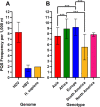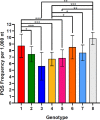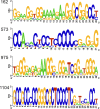Abundance of G-Quadruplex Forming Sequences in the Hepatitis Delta Virus Genomes
- PMID: 38284014
- PMCID: PMC10809645
- DOI: 10.1021/acsomega.3c09288
Abundance of G-Quadruplex Forming Sequences in the Hepatitis Delta Virus Genomes
Abstract
Hepatitis delta virus (HDV) is a highly unusual RNA satellite virus that depends on the presence of hepatitis B virus (HBV) to be infectious. Its compact and variable single-stranded RNA genome consists of eight major genotypes distributed unevenly across different continents. The significance of noncanonical secondary structures such as G-quadruplexes (G4s) is increasingly recognized at the DNA and RNA levels, particularly for transcription, replication, and translation. G4s are formed from guanine-rich sequences and have been identified in the vast majority of viral, eukaryotic, and prokaryotic genomes. In this study, we analyzed the G4 propensity of HDV genomes by using G4Hunter. Unlike HBV, which has a G4 density similar to that of the human genome, HDV displays a significantly higher number of potential quadruplex-forming sequences (PQS), with a density more than four times greater than that of the human genome. This finding suggests a critical role for G4s in HDV, especially given that the PQS regions are conserved across HDV genotypes. Furthermore, the prevalence of G4-forming sequences may represent a promising target for therapeutic interventions to control HDV replication.
© 2024 The Authors. Published by American Chemical Society.
Conflict of interest statement
The authors declare no competing financial interest.
Figures




Similar articles
-
G-quadruplexes in the evolution of hepatitis B virus.Nucleic Acids Res. 2023 Aug 11;51(14):7198-7204. doi: 10.1093/nar/gkad556. Nucleic Acids Res. 2023. PMID: 37395407 Free PMC article.
-
G-quadruplexes in H1N1 influenza genomes.BMC Genomics. 2021 Jan 23;22(1):77. doi: 10.1186/s12864-021-07377-9. BMC Genomics. 2021. PMID: 33485319 Free PMC article.
-
G-Quadruplexes in the Viral Genome: Unlocking Targets for Therapeutic Interventions and Antiviral Strategies.Viruses. 2023 Nov 5;15(11):2216. doi: 10.3390/v15112216. Viruses. 2023. PMID: 38005893 Free PMC article. Review.
-
Characterization of RNA G-quadruplexes in porcine epidemic diarrhea virus genome and the antiviral activity of G-quadruplex ligands.Int J Biol Macromol. 2023 Mar 15;231:123282. doi: 10.1016/j.ijbiomac.2023.123282. Epub 2023 Jan 16. Int J Biol Macromol. 2023. PMID: 36657537
-
G-Quadruplexes: More Than Just a Kink in Microbial Genomes.Trends Microbiol. 2019 Feb;27(2):148-163. doi: 10.1016/j.tim.2018.08.011. Epub 2018 Sep 14. Trends Microbiol. 2019. PMID: 30224157 Free PMC article. Review.
Cited by
-
A Phenotypic Approach to the Discovery of Potent G-Quadruplex Targeted Drugs.Molecules. 2024 Aug 1;29(15):3653. doi: 10.3390/molecules29153653. Molecules. 2024. PMID: 39125057 Free PMC article. Review.
-
Asymmetric distribution of G-quadruplex forming sequences in genomes of retroviruses.Sci Rep. 2025 Jan 2;15(1):76. doi: 10.1038/s41598-024-82613-2. Sci Rep. 2025. PMID: 39747944 Free PMC article.
References
LinkOut - more resources
Full Text Sources
